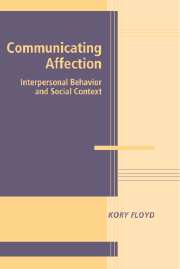Book contents
- Frontmatter
- Contents
- List of Tables
- List of Figures
- Foreword
- 1 AN INTRODUCTION TO AFFECTIONATE COMMUNICATION
- 2 THINKING ABOUT AFFECTION: THE THEORIES
- 3 ENCODING AFFECTIONATE MESSAGES
- 4 DECODING AND RESPONDING TO AFFECTIONATE EXPRESSIONS
- 5 BENEFITS OF EXPRESSING AND RECEIVING AFFECTION
- 6 RISKS ASSOCIATED WITH AFFECTIONATE COMMUNICATION
- 7 A NEW THEORETIC APPROACH
- 8 AFFECTIONATE COMMUNICATION IN HUMAN INTERACTION
- References
- Index
3 - ENCODING AFFECTIONATE MESSAGES
Published online by Cambridge University Press: 02 December 2009
- Frontmatter
- Contents
- List of Tables
- List of Figures
- Foreword
- 1 AN INTRODUCTION TO AFFECTIONATE COMMUNICATION
- 2 THINKING ABOUT AFFECTION: THE THEORIES
- 3 ENCODING AFFECTIONATE MESSAGES
- 4 DECODING AND RESPONDING TO AFFECTIONATE EXPRESSIONS
- 5 BENEFITS OF EXPRESSING AND RECEIVING AFFECTION
- 6 RISKS ASSOCIATED WITH AFFECTIONATE COMMUNICATION
- 7 A NEW THEORETIC APPROACH
- 8 AFFECTIONATE COMMUNICATION IN HUMAN INTERACTION
- References
- Index
Summary
Most people would rather give than get affection.
– AristotleHuman communication is an extraordinarily diverse enterprise, and the communication of affection is no exception. Individuals use a broad range of behaviors to encode feelings of affection for each other. Some are verbal in nature, such as a spoken or written declaration of love. Others are nonverbal gestures, such as hugs or kisses or pats on the back. Still others consist of supportive behaviors that may not necessarily be thought of as affectionate expressions but have that connotative meaning within particular relationships. This chapter explores the different forms of encoding affectionate messages (including those that are idiomatic to particular relationships), and reviews research on what individual-, relational-, and contextual-level influences affect the encoding of affection. With respect to categorizing affectionate behaviors, one might offer that they can be most parsimoniously understood as comprising three separate but interrelated types.
A Tripartite Model for Encoding Affectionate Messages
Early work on the encoding of affectionate communication adopted, at least implicitly, a two-dimensional model wherein affectionate messages were either encoded verbally (e.g., by saying “I love you” or “I care about you”) or nonverbally (e.g., by hugging, kissing, or holding hands). Many measurement models assessed verbal and nonverbal expressions without making an a priori distinction between them. For instance, Noller (1978) examined videotaped interactions of 87 parent–child dyads and coded “the number of instances of interactive behavior that would normally be regarded as affectionate,” including kissing, cuddling, or saying “I love you” (p. 317).
- Type
- Chapter
- Information
- Communicating AffectionInterpersonal Behavior and Social Context, pp. 28 - 50Publisher: Cambridge University PressPrint publication year: 2006



